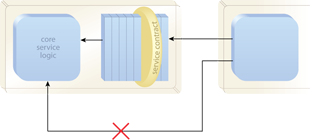SOA Patterns > Service Contract Design Patterns > Contract Centralization
Contract Centralization (Erl)
How can direct consumer-to-implementation coupling be avoided?

Problem
Consumer programs can be designed to access underlying service resources using different entry points, resulting in different forms of implementation dependencies that inhibit the service from evolving in response to change.
Solution
Access to service logic is limited to the service contract, forcing consumers to avoid implementation coupling.
Application
This pattern is realized through formal enterprise design standards and the targeted application of the Service Abstraction design principle.
Impacts
Forcing consumer programs to access service capabilities and resources via a central contract can impose performance overhead and requires on-going standardization effort.
Architecture
Composition, Service
 Through Contract Centralization we place the service contract front and center within a service architecture. This is why much of service-orientation is focused on contract design.
Through Contract Centralization we place the service contract front and center within a service architecture. This is why much of service-orientation is focused on contract design.
Related Patterns in This Catalog
Agnostic Sub-Controller, Canonical Expression, Decoupled Contract, Distributed Capability, Domain Inventory, Dual Protocols, Enterprise Inventory, Inventory Endpoint, Logic Centralization, Metadata Centralization, Multi-Channel Endpoint, Policy Centralization, Schema Centralization, Service Normalization, Service Refactoring, Trusted Subsystem
Related Service-Oriented Computing Goals
Increased Federation, Increased Intrinsic Interoperability, Reduced IT Burden
This pattern is covered in SOACP Module 7: Advanced SOA Design & Architecture with Services & Microservices.
For more information regarding the SOA Certified Pofessional (SOACP) curriculum,
visit www.arcitura.com/soa.
This page contains excerpts from:
SOA Design Patterns by Thomas Erl
(ISBN: 0136135161, Hardcover, Full-Color, 400+ Illustrations, 865 pages)
For more information about this book, visit www.arcitura.com/books.
This page contains excerpts from:
Web Service Contract Design and Versioning for SOA
by Thomas Erl, Anish Karmarkar, Priscilla Walmsley, Hugo Haas, Umit Yalcinalp, Canyang Kevin Liu, David Orchard, Andre Tost, James Pasley
For more information about this book, visit www.arcitura.com/books.


